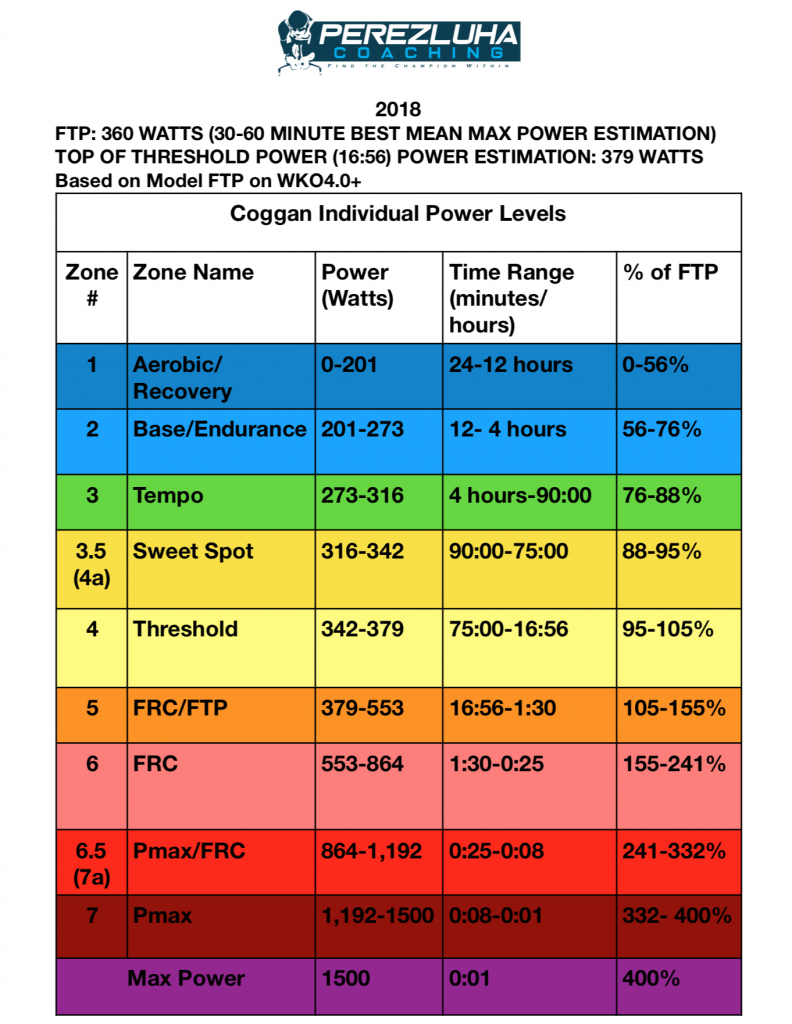Coggan Classic Power Levels vs Coggan Individualized Power Levels
In looking into the best power zones to use in cycling, I decided to look into comparing the following two:
Coggan Individual Power Levels (Model FTP) vs.
Coggan Classic Power Levels (Set FTP). In looking into these, we also jump into FRC (Functional Reserve Capacity) which is explained further down.
In cycling power zones, we typically have 6 basic power zones we work off of. These are the Coggan Classic Levels (Basic Power Zones). I am using Charles White’s power data and zones in the pictures below:
Coggan Classic Levels (basic) (see table for specifics):
1) Active Recovery
2) Endurance
3) Tempo
4) Threshold
5) V02 Max
6) Anaerobic Capacity
In looking at the table I created for Charles based on the SET FTP of 360, I added the standard timed ranges for Zones 4-6 and then estimated the time ranges for Zones 1-4. These timed ranges are in “theory” (a best performance needed in future if this power hasn’t been hit yet). In this case, Zone 5 starts with 379 watts (best 20’ power). The zone 5 range goes from 379-433 watts. The best 5 minute power Charles should be able to hit should be 433 watts. The best 20 minute power Charles should be able to hit should be 379 watts.
In the Coggan Individual Power Levels, we have 7 zones to work from with two sub-zones for a total of 9 zones:
Coggan Individual Power Levels (enhanced) (see table for specifics):
1) Active Recovery
2) Endurance
3) Tempo
3.5/4A) Sweet Spot
4) Threshold
5) FRC/FTP
6) FRC
6.5/7A) Pmax/FRC
7) Pmax
In the Coggan Individualized Power Levels, it takes the athletes model FTP (Functional Threshold Power) and FRC (Functional Reserve Capacity) into account to create power zones. Model FTP is an estimated FTP calculated through the athlete’s long term/overall training data. In these power zones, it also dives into the FRC zone (Functional Reserve Capacity). Arguably, these zones are more accurate and better to use vs the classic zones because these power zones and time ranges become more specific to the individual athlete.
In cycling, FRC is the amount of work that can be done continuously above FTP. Compared to the classic zones, FRC is a combination of Zone 5/V02 Max and Zone 6/Anaerobic Capacity. In the Coggan Individual Power Levels, FRC is zones 5-7, giving one more sub-zones to work with vs. the standard Zones 5-6 from the Classic Power levels. Having these extra sub zones in FRC gives the ability to better prescribe power intervals of around 3 minutes or less. Versus the standard Zone 6 Anaerobic Capacity zone which in this case is simply 433+ watts.
Note, the FRC will vary from athlete to athlete and the timed ranges will differ. This means the % ranges will also differ. The timed ranges for FRC are estimates of what each athlete should be able to do all out (in theory if it hasn’t happened already). In this case, Charles’s FRC range is 553-864 watts and the time range is 1:30-0:25. This means he should be able to do 553 watts for 1:30 and 864 watts for 0:25.
Why is it important to know these FRC training zones? To see how long you can ride in (average power) Anaerobic and V02 max power before your power drops back into threshold power. This length will vary from rider to rider. For Zone 5, it says Charles can ride with a mean max power of 378 watts for 16:56. After 16:56, Charles would then drop back into Zone 4/ Threshold Power.
In conclusion, the 6 Coggan Classic Power Levels will do just fine for most people. However, the Coggan Individual levels will provide a better breakdown for the classic Zone 5/V02 Max and Zone 6/Anaerobic Capacity Power. Through the Coggan Individual FRC zones, we can better prescribe Anaerobic Capacity intervals of 3 minutes or less with more specific ranges. In the Coggan Individual Power levels, each athlete’s FRC will differ in their timed ranges based on their individual training data.
Power Zones Tables:
Below are same two tables (above) with Coggan Classic Power Levels and Coggan Individualized Power Levels:

